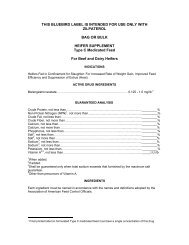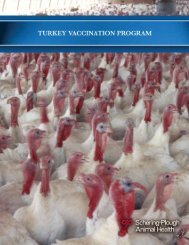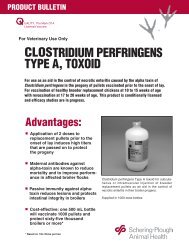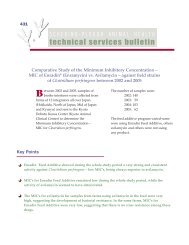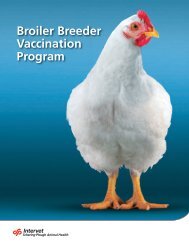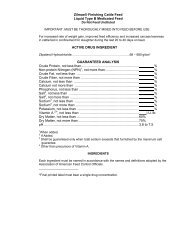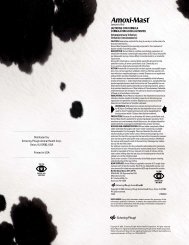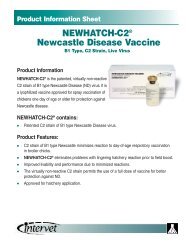B: Effect on Broiler Pigmentation - Merck Animal Health
B: Effect on Broiler Pigmentation - Merck Animal Health
B: Effect on Broiler Pigmentation - Merck Animal Health
Create successful ePaper yourself
Turn your PDF publications into a flip-book with our unique Google optimized e-Paper software.
369SCHERING-PLOUGH ANIMAL HEALTHtechnical service bulletinCoccivac ® -B: <str<strong>on</strong>g>Effect</str<strong>on</strong>g> <strong>on</strong> <strong>Broiler</strong> Pigmentati<strong>on</strong>Coccivac-B vaccine is a successful alternativeto the standard in-feed anticoccidial therapyused by most of the broiler industry. While ithas been used extensively in a wide range ofbird sizes and in many places there has been littleexperience with use of a live coccidiosis vaccinein a yellow bird program.It is known that for Coccivac-B to be successfulthere must be an adequate cycling of theoocysts. During this time period there is somedisrupti<strong>on</strong> of the intestinal lining resulting inloss of performance as compared to standardanticoccidial therapy (Mathis '99). Followingthis transient period there is healing of theintestinal wall with full recovery. Because ofthe transient disrupti<strong>on</strong>, there has been questi<strong>on</strong>sto whether Coccivac-B vaccine could beused in a yellow bird program.Key PointsBoth Coccivac-B vaccine and salinomycinperformed as expected in protectingbirds from coccidia challenge as exhibitedby OPG counts.There was no significant difference betweenthe Coccivac-B vaccine and salinomycingroups <strong>on</strong> pigmentati<strong>on</strong> scores.No reducti<strong>on</strong> in pigmentati<strong>on</strong> wasobserved by the use of Coccivac-B vaccine.Dr. Greg Mathis c<strong>on</strong>ducted a floor pen study,at the Southern Poultry Research facilities todetermine if Coccivac-B vaccine could be usedsuccessfully in a yellow bird program.Experimental DesignA total of 700 Ross X Cobb, day-old: chickswere divided into two treatment groups c<strong>on</strong>sistingof Coccivac-B dayold Spraycox ® vaccinatedand n<strong>on</strong>-vaccinated chicks. Chicks weresexed and divided equally into 14 pens with 7reps per treatment. Diets were formulated tomatch those used by an integrator producingyellow birds. Starter feed was fed from day 0to 18 days as a crumble, grower was fed from19 to 35 days and finisher was fed from 36 to44 days as pellets. To increase xanthophyll levels,all grower (12 mg/t<strong>on</strong>) and finisher (15mg/t<strong>on</strong>) feed was supplementedwith HI-Gold.One set of diets c<strong>on</strong>tained salinomycin at 66PPM in starter and grower feed while the otherc<strong>on</strong>tained no coccidiostat (Coccivac-B birds).To verify normal cycling of Coccivac-B vaccineand adequate protecti<strong>on</strong> afforded by salinomycin,oocyst shedding was examined. Onday 20 fecal samples from each pen were collectedand the oocysts per gram of fecal material(OPG) were determined by pen.Pigmentati<strong>on</strong> scores of shank and skin weretaken <strong>on</strong> days 40, 42 and 44 from 5 male and 5female birds randomly selected from each penby Dr. Greg Mathis using the Roche Color Fan.
ResultsOn day 20, the average OPG count for theCoccivac birds was 25,600, while the averagecount for the salinomycin birds was 3,100. Thisdem<strong>on</strong>strated that there was cycling of theCoccivac-B vaccine and that salinomycin wasc<strong>on</strong>trolling infecti<strong>on</strong>.Representative male and female birds from eachpen were pigmentati<strong>on</strong> scored <strong>on</strong> days 40,42 and 44. The Roche Color Fan was used todetermine pigmentati<strong>on</strong> score, which is based<strong>on</strong> a standard cotorimetric system providing anobjective color rating. Birds were not fully pigmentedby day 40 having received <strong>on</strong>ly 4 daysof the higher pigmented (15mg/t<strong>on</strong>) finisherfeed. Better pigmentati<strong>on</strong> was observed <strong>on</strong> day44 with no significant difference between treatmentgroups, although there was a numericaladvantage to the Coccivac-B group.Pigentati<strong>on</strong> Score ResultsCoccivac BSalinomycinScore Date Male Female Ave. Male Female Ave.Day 40 2.5 2.1 2.3 2.3 2.1 2.2Day 42 3.1 2.8 3.0 3.0 2.8 2.9Day 44 3.9 3.3 3.6 3.8 3.3 3.6Examples from the pigment-fedCoccivac-B and salinomycin groups to an<strong>on</strong>-pigmented salinomycin c<strong>on</strong>trolgroup (this group was fed the samerati<strong>on</strong>, minus the 15mg/t of HI-Gold).[ Innovative Soluti<strong>on</strong>s in Poultry <strong>Health</strong> ]Coccivac and Spraycox are registered trademarks of Schering-Plough <strong>Animal</strong> <strong>Health</strong> Corporati<strong>on</strong>.Copyright © 2004, 2007 Schering-Plough <strong>Animal</strong> <strong>Health</strong> Corporati<strong>on</strong>. All rights reserved.



